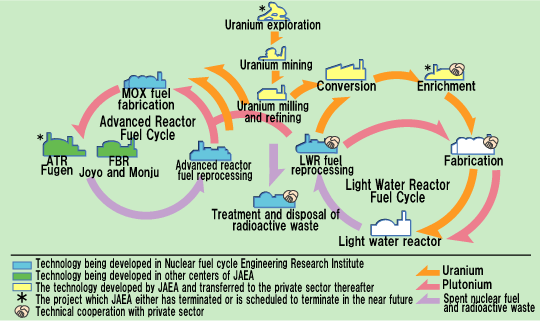
![]()
![]()
![]()
![]()
![]()
![]()
![]()
![]()
![]()
![]()
![]()
![]()
![]()
Japan Atomic Energy Agency
Tokai research and development center
Nuclear Fuel Cycle Engineering Laboratories
4-33, Muramatsu, Tokai-mura, Naka-gun, Ibaraki,
Japan 319-1194
tel;029-282-1111
In order to maintain and further improve the living standard all of us are currently enjoying, stable supply of energy is essential.For Japan, which imports roughly 80% of its energy resources due to the lack of its own resources, the utilization of nuclear energy is one of the most viable options with the view of securing energy in the long term.
Japan Atomic Energy Agency is pursuing R&D for the establishment of nuclear fuel cycle in which nuclear energy is efficiently utilized.
Our Tokai Works has achieved a lot in the field of R&D for nuclear fuel cycle and intends to do so in the future.

Emergency Control Center |
Recycle Equipment Test Facility(under construction) |
Plutonium Fuel Production Facility |
|||
Health and Safety Administration Building |
Chemical Processing Facility |
Engineering Scale Test and Research Facility |
|||
Tokai Reprocessing Plant |
Engineering Demonstration Facility III |
Quantitative Assessment Radionuclide Migration Experimental Facility |
|||
Tokai Vitrification Facility |

Uranium ore turns into fuel assemblies for nuclear power stations after undergoing the treatment process of milling, refinement, conversion, enrichment, and fabrication. Reprocessing collects residual uranium and produced plutonium from the spent fuel which are used for fabrication of new fuel assemblies.
This process flow is called the nuclear fuel cycle.
June |
1957 |
Establishment of the Tokai Refinery, Nuclear Fuel Corporation (NFC) |
March |
1959 |
First successful production of metallic uranium in Japan |
March |
1959 |
Inauguration ceremony for the Tokai Refinery, NFC |
January |
1966 |
First receipt of plutonium. Start of plutonium fuel development at the Plutonium Fuel Development Facility (PFDF) |
October |
1967 |
Establishment of the Power Reactor and Nuclear Fuel Development Corporation (PNC) which succeeds NFC |
May |
1969 |
First successful uranium enrichment test using the centrifugal separation method |
June |
1971 |
Start of construction of the Tokai Reprocessing Plant (TRP) |
November |
1972 |
Start of fuel fabrication for the experimental fast reactor "Joyo" at the Plutonium Fuel Fabrication Facility (PFFF) |
July |
1975 |
Start of fuel fabrication for the advanced thermal reactor "Fugen" at the Plutonium Fuel Fabrication Facility (PFFF) |
September |
1977 |
Start of test utilizing spent fuel at the Tokai Reprocessing Plant (TRP) |
January |
1981 |
Start of full scale operation at the Tokai Reprocessing Plant (TRP) |
September |
1982 |
Start of reprocessing test using fuels from the experimental fast reactor "Joyo" at the Chemical Processing Facility (CPF) |
December |
1982 |
Start of basic vitrification test using high-level radioactive liquid waste at the Chemical Processing Facility (CPF) |
October |
1989 |
Start of fuel production for the prototype fast breeder reactor "Monju" at the Plutonium Fuel Production Facility (PFPF) |
August |
1993 |
Completion of the Engineering-scale Test and Research Facility(ENTRY) |
January |
1994 |
Completion of production of the initial loading fuel for the prototype fast breeder reactor "Monju" at the Plutonium Fuel Production Facility (PFPF) |
January |
1995 |
Start of construction of the Recycle Equipment Test Facility (RETF) |
January |
1995 |
Start of vitrified waste production at the Tokai Vitrification Facility (TVF) |
March |
1997 |
Fire and explosion at the Bituminization Facility |
October |
1998 |
Establishment of the Japan Nuclear Cycle Development Institute (JNC) which succeeds PNC |
August |
1999 |
Completion and start of the operation of the Quantitative Assessment Radionuclide Migration Experimental Facility (QUARITY) |
November |
2000 |
Resumption of the operation of Tokai Reprocessing Plant (TRP) |
March |
2002 |
Tokai Works obtained the certificate of both OHSAS 18001 and ISO 1400 |
June |
2002 |
1000t of accumulation reprocessing at the Tokai Reprocessing Plant (TRP) |
July |
2004 |
Start of the dry process reprocessing test using plutonium |
October |
2005 |
Inauguration of Japan Atomic Energy Agency |
March |
2006 |
Accomplishment of LWR spent fuel reprocessing at the Tokai Reprocessing Plant |
April |
2008 |
Execution of Agreement between the Japan Atomic Energy Agency and Idaho National Laboratory for cooperation of personnel training in fuel cycle area by exchanging personnel |
March |
2010 |
Plutonium Fuel Development Center obtained the certificate of ISO17025 |
Copyright(C) Japan Atomic Energy Agency. All Right Reserved